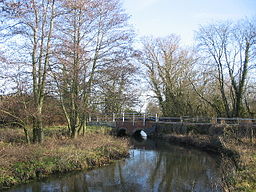River Wylye
| River Wylye | |
| River | |
|
River Wylye at Norton Bavant
|
|
| Country | England |
|---|---|
| Tributaries | |
| - left | Chitterne Brook, River Till |
| Cities | Maiden Bradley, Warminster, Codford St Peter, Wilton |
| Source | Rodmead Farm |
| - location | Maiden Bradley, Wiltshire, England |
| - elevation | 148 m (486 ft) |
| - coordinates | 51°07′25″N 2°18′11″W / 51.12361°N 2.30306°W |
| Mouth | Confluence with River Nadder |
| - location | Wilton, Wiltshire, England |
| - elevation | 69 m (226 ft) |
| - coordinates | 51°04′45″N 1°51′45″W / 51.07917°N 1.86250°WCoordinates: 51°04′45″N 1°51′45″W / 51.07917°N 1.86250°W |
| Length | 45 km (28 mi) |
| Basin | 470 km2 (181 sq mi) |
| Discharge | for Chitterne Brook[1] |
| - average | 0.3 m3/s (11 cu ft/s) |
| - max | 0.6 m3/s (21 cu ft/s) |
| - min | 0.1 m3/s (4 cu ft/s) |
The River Wylye (/ˈwaɪli/ WY-lee) is a classic southern England chalk stream; champagne clear water flowing over gravel. Consequently, it is popular with anglers keen on fly fishing. A half-mile stretch of the river and three lakes in Warminster are a local nature reserve.
The Wylye rises below the White Sheet Downs just south of Maiden Bradley in Wiltshire, and after flowing through the Deverill valley, forms the southern edge of Warminster. It then heads generally east south east, forming the Wylye Valley, into which the A36 road and the Wessex Main Line are also squeezed. The river passes through the parishes of Norton Bavant, Heytesbury, Knook, Upton Lovell, Boyton, Codford, Wylye and Wilton, near the southern edge of Salisbury Plain, and is fed by ephemeral, winterbourne streams so water flow can vary.
...
Wikipedia

